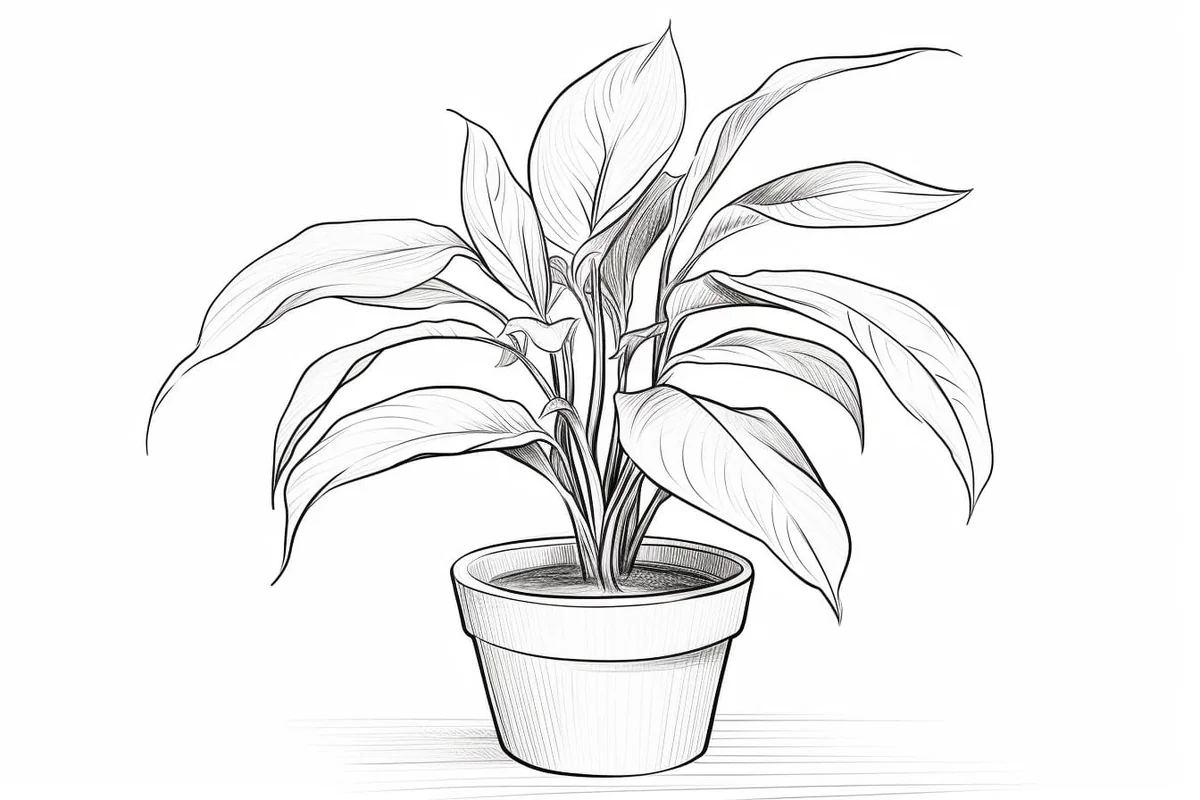How to Draw a Plant in 6 Easy Steps
Learn how to draw with this step-by-step tutorial.

Materials You'll Need
- Drawing paper
- Pencil (HB or 2B)
- Eraser
- Colored pencils
- Watercolor paints

Welcome to this creative journey into the world of botanical art! Plants, with their endless variety of shapes, textures, and colors, are one of the most rewarding subjects to draw. From elegant flowers to lush, leafy houseplants, capturing the beauty of nature on paper can be both relaxing and inspiring.
In this step-by-step tutorial, you'll learn how to draw a plant in a way that feels approachable and fun. Whether you're a budding artist exploring drawing a beautiful flower or someone with a green thumb wanting to combine art and nature, this guide is perfect for you. We'll break the process into simple steps, covering everything from sketching the basic structure to adding intricate details and vibrant colors that bring your plant to life.
So, grab your pencils, paper, and favorite art supplies, and find a cozy spot to work. By the end of this guide, you'll have created a realistic and vibrant plant drawing that celebrates the beauty of the natural world. Let's dive in and let your creativity grow!



Materials Required
-
Eraser
Now let's cover how to draw a plant step-by-step.
Step 1: Illustrating the Stem
Initiate your botanical drawing journey by illustrating the stem of the plant. Begin by sketching a sturdy, straight line at the center of your paper, laying the foundation as the main stem of your plant. This central line will guide the placement of leaves and possibly flowers, defining the basic structure of your plant illustration.
Step 2: Leafing Out Your Plant
Transition now to adorning your plant with leaves. Sketch small ovals or elongated forms along the stem, ensuring a sporadic placement to mimic nature's randomness. Embrace variety in the size, shape, and angle of the leaves, instilling a natural, organic aura to your plant illustration.
Step 3: Blooming Creativity (Optional)
Should you venture to draw a flowering plant, this is your moment to let creativity bloom. Sketch small circles or varying shapes at the tips of stems, marking the buds of flowers. Elaborate by adding delicate petals and intricate details, enhancing the realistic allure of your blossoms.
Step 4: Veining the Leaves
Now, delve into detailing the leaves. Illustrate veins branching out from the central vein to the edges of the leaves. Infuse life into your foliage by sketching subtle lines, adding texture and dimension. Introduce minor irregularities along the leaf edges to capture the essence of nature's imperfections.
Step 5: Shading and Texturing for Realism
Elevate the realism of your plant drawing through the art of shading and texturing. Shade the under regions of the leaves and around the stems where shadows naturally cast. Employ short, curved lines to mimic the texture and patterns on the leaves and flowers, adding a tactile feel to your botanical artwork.
Step 6: Refinements and Final Flourishes
Pause and step back, evaluating your drawing from a holistic standpoint. Identify areas needing adjustment and add those finishing touches that resonate with you, refining your plant drawing. Your meticulousness in this final stage breathes life into the paper, making your plant illustration flourish.
Final Sprouts: Reflecting on Your Greenery
As you reflect on your artistic endeavor, admire the harmony of lines, shades, and textures in your plant drawing. Your attention to detail honed your botanical illustration skills and forged a deeper connection between you and the verdant charm of nature. This reflective moment marks not just the completion of an artwork but a journey of growth akin to the plant you've meticulously illustrated.
Wrapping Up How to Draw a Plant
Congratulations! You have successfully drawn a plant. Whether it's a beautiful flower or a lush houseplant, with practice and creativity, you can draw a variety of plants with different shapes and forms. So, grab your pencil and let your imagination bloom as you create your botanical masterpieces with this "How to Draw a Plant" tutorial.
Gallery of Plant Drawings







Tip: To enhance your plant drawing, start by observing the real plant closely or use a high-quality reference photo. Focus on the light source and how it affects the shadows and highlights on the leaves; this will add depth to your drawing. Use a combination of smooth and textured strokes to replicate the varied surfaces of the leaves and stems—try a soft pencil for the smooth areas and a harder pencil for sharper details. Don't rush the process; layer your colors gradually, allowing each layer to dry if using watercolor or colored pencils, which can help achieve a more vibrant look. Finally, take a step back frequently to assess your work from a distance; this will help you notice areas that need adjustment and keep your proportions accurate.
Fun Facts About Plants
Plants are fascinating organisms with a myriad of intriguing attributes. Here are some interesting facts about plants to consider as you learn how to draw a plant.
-
Photosynthesis: Plants possess the remarkable ability to convert sunlight into energy through a process called photosynthesis. This process also produces oxygen, which is vital for the survival of many other organisms, including humans.
-
Diversity: The plant kingdom is incredibly diverse, with over 390,000 known species of plants. This diversity ranges from tiny mosses to giant redwood trees.
-
Oldest Living Organisms: Some plants rank among the oldest living organisms on Earth. For instance, the Pando colony of Quaking Aspen trees in Utah is estimated to be thousands of years old.
-
Sensory Perception: While they lack a nervous system, plants can sense their environment in a variety of ways. They can respond to light, gravity, touch, and even certain chemicals in the soil.
-
Communication: Plants can communicate with each other through a network of fungal mycelium in the soil, often referred to as the "Wood Wide Web." They can send nutrients and warnings about pests to other plants via this underground network.
-
Medicinal Value: A large number of medicines are derived from plants. For example, aspirin originated from willow bark, and morphine comes from the opium poppy.
-
Carnivorous Plants: Some plants, like the Venus flytrap and pitcher plants, are carnivorous. They have evolved to catch and digest insects and other small organisms to supplement their nutrient intake in nutrient-poor soils.
-
Aerial Plants: Epiphytes or aerial plants, like orchids and bromeliads, live on other plants and get their nutrients from the air, rain, and debris around them, rather than from the soil.
-
Seed Dispersal: Plants have devised ingenious seed dispersal methods to ensure their species' continuation. Some seeds float and are carried by water, and others are encased in fruits and eaten by animals who later excrete them in different locations, while some seeds have wings or other structures that allow them to be carried by the wind.
-
Floral Scents and Colors: Plants employ a variety of scents and colors to attract or repel certain insects and animals. For instance, flowers often have bright colors and sweet scents to attract pollinators, while some plants have unpleasant odors to deter herbivores.
-
Tropism: Plants exhibit tropism, a movement in response to environmental stimuli. Phototropism is a response to light, gravitropism (or geotropism) is a response to gravity, and hydrotropism is a response to water, guiding the plant's growth and development.
-
Sleep Movements: Some plants exhibit sleep movements, known as nyctinasty, where they fold their leaves and/or lower their branches at night and reopen them in the morning.
-
Growth Rings: Many trees produce growth rings which can tell us much about the conditions in which the tree grew. The width and color of tree rings can provide information about the age of the tree, as well as the climate conditions (wet versus dry years) during each period of growth.
-
Hyperaccumulators: Some plants are known as hyperaccumulators because they have the ability to take up and store high concentrations of toxic metals like nickel, cadmium, and zinc in their leaves and stems. This attribute can be used for phytoremediation, a method of cleaning up soil contamination.
-
Alkaloid Production: Many plants produce alkaloids, which are nitrogen-based compounds with a wide range of pharmacological effects on humans and other animals. For example, caffeine, nicotine, and quinine are all alkaloids derived from plants.
Now that you've learned how to draw a plant and are armed with fun and interesting facts, it's time to crack out the pencils and start drawing!